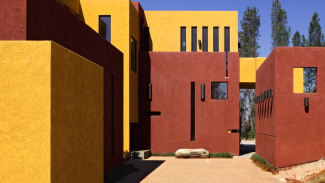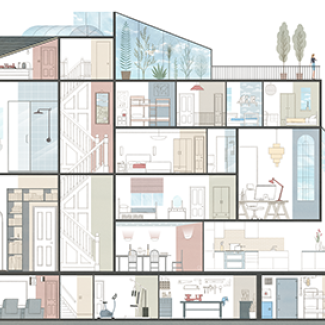House of love: how a pair of architects use their work and travels to keep their marriage strong
Steven and Cathi House have been married and working together for nearly 50 years. To celebrate Valentine's Day we talked with the Houses about the story of their marriage, their extensive travels and how it impacts their work, and the benefits of working together as a couple.

Steven and Cathi House of House + House Architects have been married and working together for nearly fifty years. Based in San Francisco, the Houses work primarily in “personal architecture,” where they’ve won myriad awards for residential design.
The couple spend around three months a year living in San Miguel de Allende, Mexico, a small city filled with creative people around three and a half hours northwest of Mexico City. There they run the aptly named CASA, or the Center for Architecture, Sustainability, and Art, an intimate program for around eight students where the stated goal is to “instill in students a holistic view of what it truly means to be an architect.”
Additionally, the Houses have written five books documenting vernacular architecture around the world. Their latest, San Miguel de Allende: The Soul of Mexico, came out last year.
The Houses spoke with the AIA Architect about how they met, how travel shaped their philosophies as architects, and why their differences make them a good team.
What inspired each of you to become architects? What is the story behind your marriage?
Cathi House: I think I was born an architect. I grew up a military child and most of my childhood was spent in Panama. By age four I was redrawing what I thought were better floor plans for the places we were living. By eight I knew what an architect was and told my parents that is what I wanted to be. They didn’t know what that really was, but they were excited I was so determined at a young age.
Steven House, AIA: As a child I was passionate about art, I was always drawing and painting. I loved Walt Disney movies and cartoons and I wanted to work for Disney as an artist. When I mentioned that to my parents they said I probably wouldn’t make any money being an artist and I should think about engineering.
Around tenth grade, my father, who was a big Virginia Tech football fan, took me to a game and I had a chance to visit the architecture school there. I met the dean and a couple of the students and instantly thought “oh my God, this is amazing, this is exactly what I want to do.” I realized architecture was a blend between art and engineering so that seemed the perfect direction.
Cathi: I also wound up at Virginia Tech. We both came into the College of Architecture that had developed a unique intensive education modeled after the Bauhaus, emphasizing design at all scales and the inter-relatedness of all forms of art and architecture. It was an extraordinary time to be there.
Steven: My college roommate was also studying architecture. During our first week as freshman in the fall of 1970 we sat next to each other in a design studio. The first project we were given was to make a bridge out of balsa wood and paper clips. Our professor gave us a week or so to do it, and after the first day my roommate said “Steven, have you seen what Cathi is doing?”
I walked over and looked over her shoulder and Cathi was designing the most amazing thing. I introduced myself and asked how she was doing, hers was clearly the best project in our class. A few weeks later, we were doing an all-nighter with some people from the program and Cathi was there. I decided to walk over and ask her if she wanted to go out for some ice cream at the all-night ice cream parlor down the street. Cathi ordered an ice cream cone with chocolate and orange sherbet, and said “but be sure to put the chocolate on the bottom”. I turned to her and asked “why does that really matter,” and she said “Steven, everything matters!”
We slowly started dating, one thing led to the next and we ended up getting married the day after graduation. We graduated on a Saturday and got married on the Sunday in Blacksburg [Virginia, home of Virginia Tech].

You’ve written five books documenting architecture and design around the world. How has that extensive travel shaped your philosophies as architects and influenced the work you do?
Steven: Cathi and I decided early on that travel was going to be very important to our life. After graduation we moved to Philadelphia and worked for about a year and a half while saving money to travel.
Cathi: We started in Central Europe, seeing all of the classic buildings you learn about in a history of architecture class. At the time we’d never heard the words “vernacular” or “indigenous”. We were traveling on a very modest budget, staying in places that were architecturally interesting, but lacking modern comforts.
By the time we made it to Athens I had gotten very sick. I had a raging fever and was in and out of delirium. There was a poster on the wall of something I had never imagined possible to exist. It was a photograph of the island of Santorini. As I was coming in and out of my fever I told Steven “If I’m going to die, I want to die there.”
Steven figured out where that was, and as soon as I could stand up and walk, we got an 18-hour boat to Santorini, arriving at midnight. All you could see of the village 1,000 feet up the cliff was a row of lights that looked like stars had gathered into a line. When we woke up the next morning we opened the windows and looked out over the caldera and saw the most incredible classic view of Santorini.
Then I looked down. Below our balcony on the roof of one of the houses was a stairway carved into the cliff. The stairway was sinuous and beautiful. It twisted and turned and gave you a view and then took away the view. I thought about how walking on that staircase was like a dance. In that moment I was changed and feel like the soul of the architect I have become was born.
We ran out as fast as we could and couldn’t believe every view, every idea, the way every building set together and how the streets moved among them, everything about it was so sensual and captivating and awe-inspiring.
We ended up staying on Santorini for six months. The first thing we learned to say in Greek was “Hello, we are architects, can we come in your house and sketch?” Every day was a revelation to us. Every day we found new ways to think about architecture. In that place our philosophy of life and our philosophy of architecture was born.
Steven: We took thousands of photographs and did hundreds of sketches. After Santorini we continued into Yugoslavia and Spain and all over southern Europe. That trip was the impetus for our first book, Mediterranean Villages: an architectural journey.
Can you describe the biggest challenges and benefits of working with your longtime partner?
Steven: Cathi and I are very different in the way we think and the way we work. We’ve managed to figure out obstacles and things like that. Being married and working together has actually helped us in many ways. We critique each other, we’re honest with each other and we don’t take things personally. We’ve tried very hard to cultivate that throughout the years.
Cathi: We are so different in the way we think and I believe that makes us a strong team. We see things from different perspectives and when we bring them together it’s broadly thought about.

How is sustainability central to your practice?
Cathi: One of our good friends had a very good answer to this question. He said “given that the largest pile of debris that you can put into a dump is a building that’s torn down because it doesn’t serve it’s purpose anymore.” He said the best thing you can do for sustainability is to design well so that your buildings last. We try to be as thoughtful as we can about every single decision we make.
What are some of the key challenges facing the future of architecture? What are your thoughts on the state of the profession in 2024 and beyond?
Steven: Young people who are coming out of school are trained constantly on the computer. I wish they were better taught to communicate through hand-drawing and to not just rely on a computer.
Cathi: It would be wonderful if firms stepped back for a moment and realized what a resource their staff are. To help guide them and watch over them as you would with any child who is starting with something new can make the work joyous.
It would be nice if we could all take a pause for a moment and think about what the essence is of what we’re trying to do. Are we trying to have firms filled with creative people doing things that are meaningful in the world? If that’s true we need to talk about it, work about it, study about it, research about it.
Everyone seems in such a hurry right now. If you’re a junior architect, you might not have the chance to discuss the project with the partners - how sad is that?
The world is changing quickly, technology is evolving quickly, but we as humans are not. Architecture is still done in the same way as it was when the Parthenon was built. Buildings, even high rises, are built by hand, and that idea has slipped away from people. Think about those hands, who do they belong to? How do you bring magic and spirituality and soulfulness into the work you’re doing? I think that’s what we should be working towards, but I’m not sure that’s where anyone else is looking.
A gallery showing photographs from the Houses’ most recent book San Miguel de Allende: the soul of mexico will be on display at San Francisco’s Center for Architecture + Design from March 22- May 3 with an opening reception and lecture on Thursday, March 28 from 6-8pm. Learn more about the event and register to attend here.




